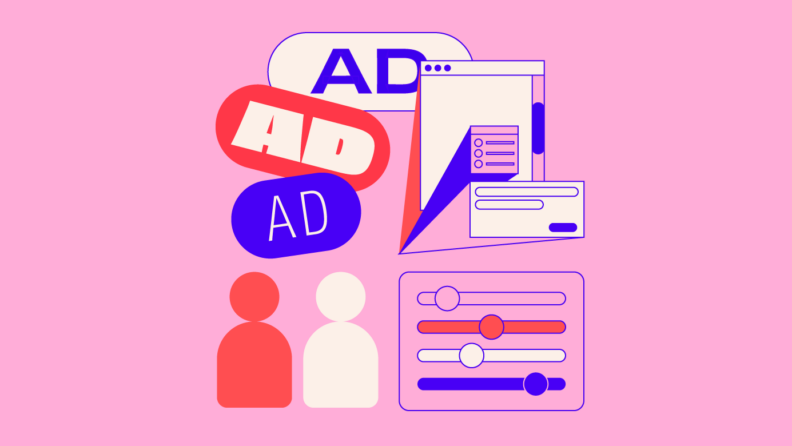Personalization is a powerful tool that has become a mainstay of modern marketing. Of course, nowhere is this more relevant than in account-based marketing—the practice of targeting specific high-value accounts with personalized content.
While search engines and social media platforms can facilitate the delivery of personalized ads at scale, data privacy becomes a growing concern. Companies that have profited off of readily available consumer data are now having to get creative to capture the necessary insights to deliver personalized ads.
In this article, I’ll share exactly what ad personalization entails, and how businesses are successfully adapting to changing laws around data privacy to continue delivering relevant ads that support their ABM strategy.
What Is Ad Personalization?
Ad personalization is the process of extracting user data, be it demographic, geographic, psychographic, or behavioral such as search history, and leveraging it to create online ads that match a person’s specific interests.
By gaining a deeper understanding of your potential customers, their likes and dislikes, and what products they’ve been interested in the past, you can tailor your online advertising to effectively market the right products and services.
Why Should I Use Personalized Ads?
Personalization is no longer a nice-to-have, it’s a necessity—especially when it comes to ABM. Luckily, you can use specialized ABM software to help you gather intent data and personalize your marketing efforts at scale.
The level and consistency of that personalization often depends on your approach: omnichannel or multichannel. Omnichannel strategies prioritize a unified experience across touchpoints, while multichannel strategies may personalize in silos.
Consumers in a recent McKinsey survey reported overall positive feelings towards personalized marketing tactics, like personalized ads, stating that it made them feel special and seen by the advertiser. In fact, 71 percent of consumers said they expect companies to deliver a personalized customer experience, and 76 percent get frustrated when this doesn’t happen.
While a good personalization strategy can conjure up good feelings on the consumer side, it also presents substantial benefits for businesses, such as:
- Reducing customer acquisition costs by up to 50 percent
- Lifting revenues by 5 to 15 percent
- Increasing marketing ROI by 10 to 30 percent
Personalization improves performance and delivers better customer outcomes. McKinsey research indicates that personalized experiences enhance both customer loyalty and a company’s gross sales. Companies experiencing faster growth rates obtain 40 percent more of their revenue from personalization compared to slower-growing counterparts.
Where Can I Use Personalized Ads?
Personalized ads can consist of various ad formats. Here are just some examples of popular advertising platforms and formats:
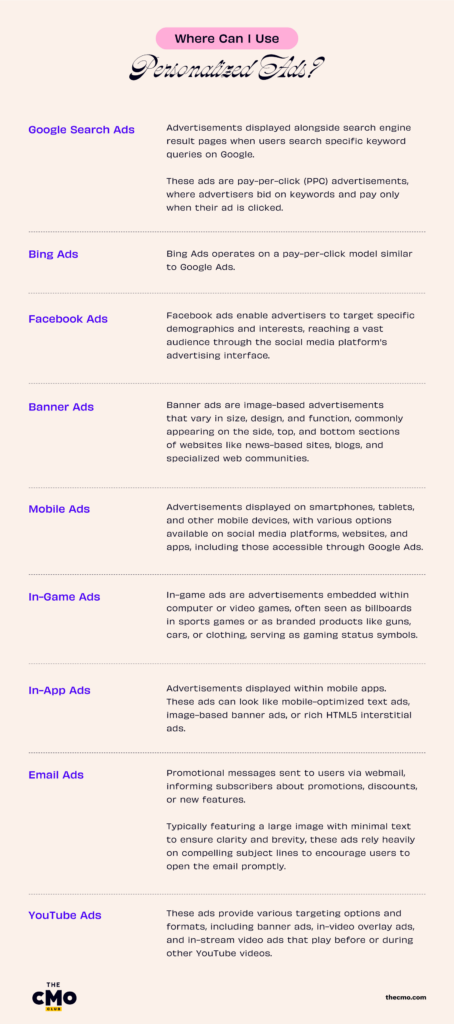
Types Of Personalized Advertising
Demographic
Demographic personalization entails customizing advertisements to align with the specific demographic attributes of the target audience. This approach allows advertisers to craft messages tailored to characteristics like age, gender, location, or interests.

Behavioral
Behavioral targeting involves directing ads towards users according to their online behaviors and browsing habits through the analysis of data like search history, website visits, and past interactions.
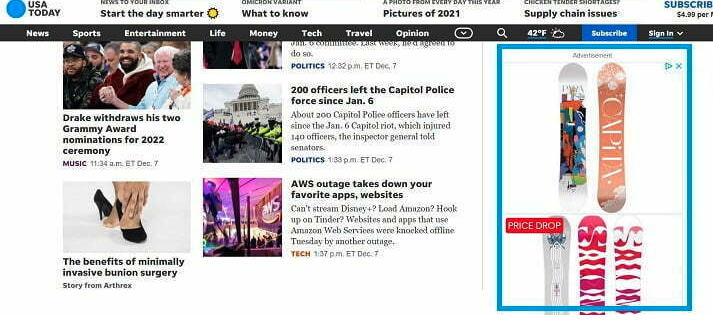
Context-based
Contextual targeting on display networks is a powerful audience targeting approach in digital advertising, wherein ads are strategically placed on websites relevant to the target audience.

Predictive
Predictive personalization uses algorithms and machine learning to forecast customers’ future behaviors, needs, and desires. This predictive personalization heavily depends on consumer data to disseminate customized offers, products, or messages to targeted audiences across various channels and touchpoints.

Retargeting
By incorporating customer data into remarketing lists, such as email addresses, phone numbers, or past purchase history, you can tailor ads to individuals who have previously visited your website or made a purchase.
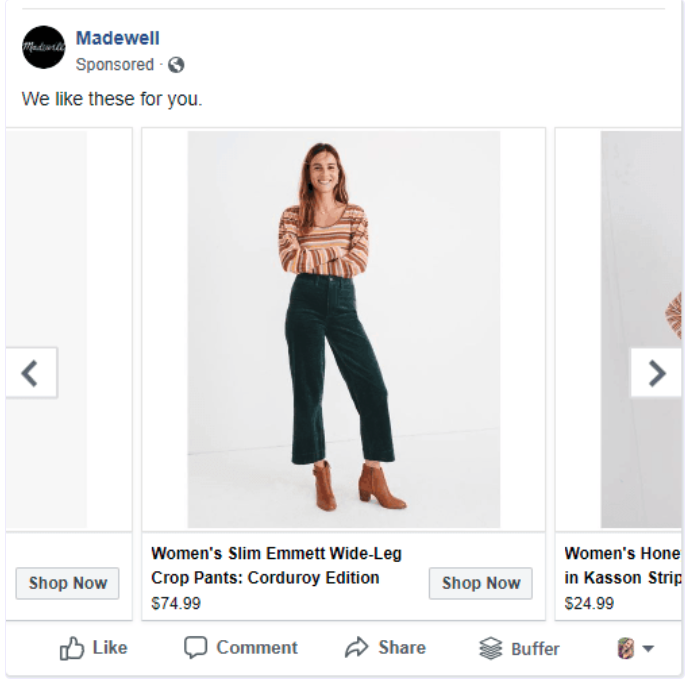
How To Create Personalized Ads In 3 Simple Steps
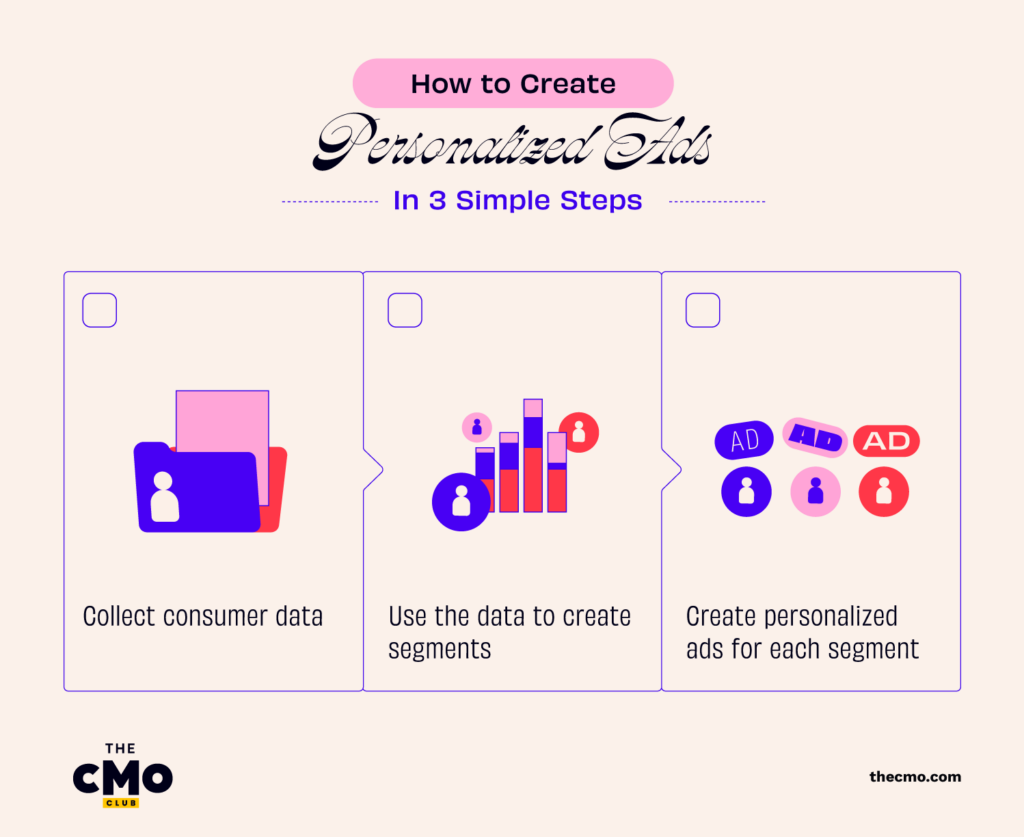
1. Collect consumer data
Information plays a vital role in personalized advertising, empowering advertisers to craft ads that are more relevant, impactful, and engaging, while also ensuring they reach the right audiences. The more information advertisers have at their disposal, the greater their likelihood of achieving success in personalization efforts.
Key channels for data collection include:
- Web analytics: This involves tracking and analyzing data related to website traffic, such as visitor numbers, demographics, location, and on-site behavior. There are a number of great marketing analytics tools you can use to gather this.
- Customer data platforms (CDPs): CDPs are systems designed to collect, store, and manage customer data from various sources. They can collect information from a customer's interactions with a brand across online and offline channels, including website activity, purchase history, and email.
- Third-party data providers: These providers gather and sell data about consumers from diverse sources, spanning online and offline transactions, social media activity, and more.
- Surveys and forms: One way to collect valuable data is by inviting consumers to complete surveys or forms, which gather insights into their interests, demographics, and behaviors.
- Social media platforms: Social media platforms gather extensive data about their users, encompassing their interests, behaviors, and demographics.
2. Use the data to create segments
After gathering customer data, you need to analyze it to uncover patterns and trends that can shape your segmentation strategy. You might use tools like data visualization, statistical analysis, or machine learning algorithms to reveal insights hidden within your data.
Once you’ve analyzed your data, you’ll be better able to divide your customer base into distinct groups based on characteristics or behaviors. These groups share similar traits, making them more likely to respond similarly to marketing efforts or have similar needs.
By segmenting your customers, you can tailor your marketing strategies, products, and services to better meet the needs and preferences of each group, ultimately improving customer satisfaction and driving sales.
- Geographic segmentation involves grouping customers by location to better understand their needs and preferences, often using IP geolocation through services like Google Maps for ad campaigns.
- Demographic segmentation categorizes customers by age, marital status, occupation, and more, allowing tailored campaigns for different demographics.
- Psychographic segmentation focuses on lifestyle and values, while behavioral segmentation
- Behavioral segmentation looks at customer behavior, such as online shopping habits
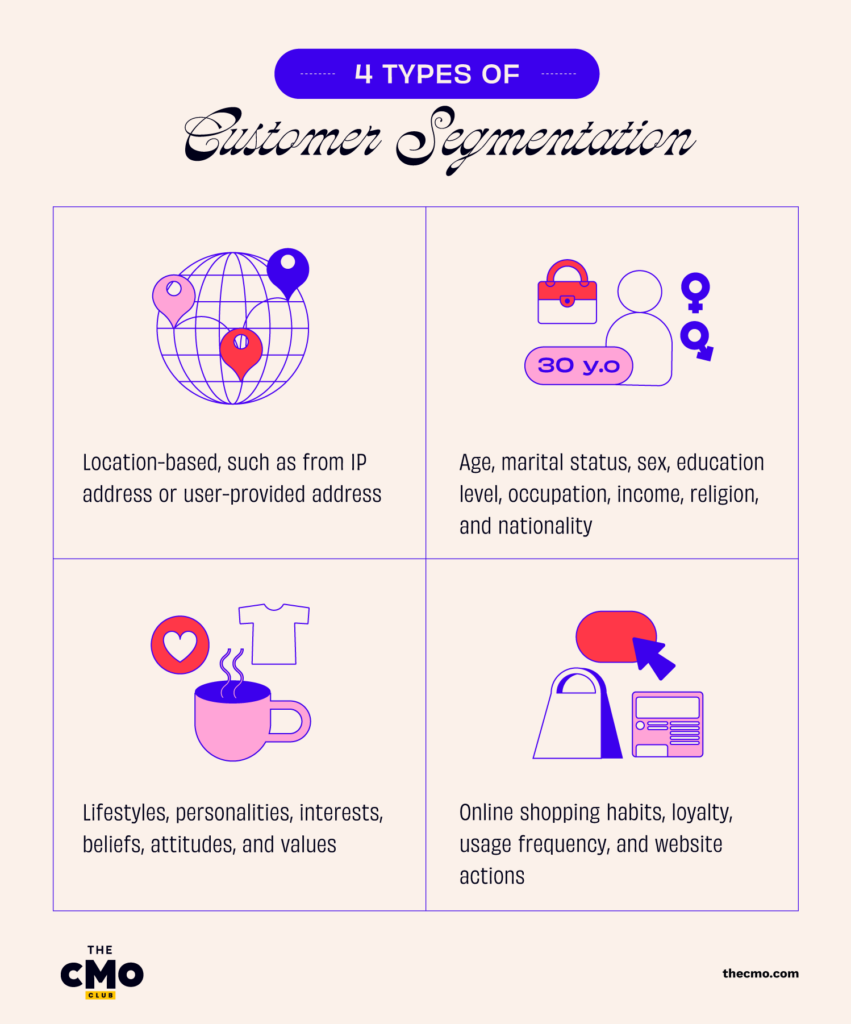
3. Create personalized ads for each segment
Once you've segmented your audience and collected data on their behavior and preferences, the next step is crafting targeted ads and offers that resonate with each segment. This means tailoring your digital marketing campaigns and ABM ideas to meet the specific needs and interests of each group, creating a sense of relevance and urgency.
These are just some of the strategies you can use to create personalized ads:
- Customization: Use customer names, purchase history, or other personal details to craft messages and offers specific to their needs and interests, fostering a deeper connection.
- Behavioral triggers: Develop messages and offers triggered by specific customer actions, like abandoned carts or website visits, to create urgency and boost conversion.
- Promotions and incentives: Offer discounts or incentives tailored to each segment's needs to encourage desired actions, such as making a purchase or subscribing to a newsletter, enhancing perceived value and urgency.
- Content marketing: Create targeted content, like blog posts or social media updates, addressing the unique interests and needs of each segment, building trust and authority.
Ultimately, tailoring messages and offers to each segment is vital for effective customer segmentation, cultivating a sense of relevance and urgency that drives engagement and conversion.
Best Practices For Ad Personalization
Make sure you consider data privacy
Personalized advertising relies on the collections and use of consumer data. Recently, this practice has come under scrutiny due to escalating privacy concerns among consumers.
Advertisers are obligated to adhere to data privacy laws and regulations like the General Data Protection Regulation (GDPR) in the European Union and the California Consumer Privacy Act (CCPA) in the United States. These regulations mandate transparent and compliant handling of consumer data, ensuring it respects consumer privacy rights.
Mirror the customer journey
A straightforward approach to achieving success with personalized ads involves tailoring campaigns to suit each stage of the sales cycle.
Start by introducing your brand and products to shoppers who have recently discovered your brand, offer relevant product suggestions to those who have explored multiple product pages, and retarget existing shoppers with highly personalized ads based on their past purchases and timing.
Align ads with landing pages
Even with the most personalized ad, if a user clicks through to the landing page and doesn't find the information they seek, it's ineffective. Ensure that you keep a consistent experience by personalizing your ABM landing pages, addressing the shopper or account by name, highlighting relevant products, and offering incentives based on their position in the customer journey.
Measure, experiment, and optimize
Measuring personalized campaign success is crucial for refining marketing strategies. Some ABM metrics you might want to consider include:
- conversion rates
- click-through rates
- customer lifetime value
- A/B testing results
Surveys and feedback also provide valuable insights for improvement. With a data-driven approach and willingness to iterate, businesses can create more effective personalized campaigns that drive results.
According to Tony Uphoff, CEO of Business.com, repeat engagement is the marker of successful personalization. Uphoff emphasizes the importance of establishing clear objectives and key performance indicators (KPIs). He states:
At Business.com, we've established several tangible objectives, such as boosting registration rates, encouraging repeat visits, prolonging site visit durations, and reducing unsubscription rates.
Tony Uphoff, CEO of Business.com
Subscribe For More Marketing Insights
Personalization is key in today's marketing world, especially with strategies like account-based marketing. As you'll find in some of the best account-based marketing examples, it's all about finding creative ways to understand consumers better while also respecting their privacy concerns.
When it comes to ad personalization, data analysis is vital to making ads more relevant to your customer's interests, preferences, and behaviors. To learn more about ABM and other tactics, subscribe to The CMO newsletter.

